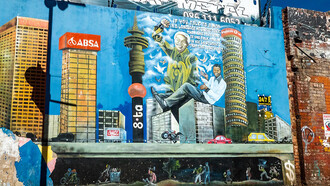Just in case you’re a locked-down speleologist or If you haven’t engaged with the world from your hermetically sealed chamber for fear of infection, I thought that this month I would tackle one of the most contentious and difficult subjects to hit der infobahn over the past couple of months in relation to Black Lives Matter. Namely, this text concerns itself with the collision between commemorative public statuary and contemporary ethics – the point where the meat truly is meeting the metal1.
The fact is that the history of the world, and particularly the capitalistic development of the West, has been consistently nourished by a diet of enslavement, exploitation, plunder, oppression and occupation - with some more-or-less acknowledged genocides on the way. If you think this is harsh, then you are probably white, western and feel vaguely discomfited by the way your world is unravelling currently.
To explain why we (and I include myself absolutely in this btw), can’t interpolate or articulate our range of current collective situations effectively, we have only to look to the gaps in our education. Sure, there are exceptions to this gap assertion, but the fact is that state school students in England in the 1970’s weren’t really taught about the history and legacy of slavery, the establishment of Empire or their impacts any more than they were about the truth(s) behind The Irish Question2 in Ireland. This just as the narrative of 20th century history for school students in West Germany in the 1970’s halted at the conclusion of the First World War. How many schools in the US deal honestly with the treatment of the indigenous peoples of the United States, but let’s face it most nations have some skeletons that they would rather keep firmly in the family clothes repository.
Now then, what has gone around has come around and the monumentalised public expressions of corollary binary events or persons (freedom at the expense of the oppressed, profit at the expense of the exploited, military victory at the expense of the vanquished, homeland expansion at the expense of the diaspora, etc. etc.). So, it has come to pass that the effigies of key figures associated with momentous events or moments in human history have come to act as lenses that magnify the soil of our chequered histories and in turn to cleave communities that have rubbed along abrasively for tens, hundreds or even thousands of years.
But iconoclasm is not a new phenomenon, and while we may be shocked by the mob toppling of the Bristolian statue3 of the 17th century slaver Edward Colston, or the attempted incineration of the bronze of King Leopold II of Belgium (and author of untold atrocities in the former Belgian Congo), we need to keep this in perspective. Recent events, whilst newsworthy, are absolutely without proportion in relation to the mass destruction of classical Greek statuary by Christian fundamentalists in the fourth century (IS eat your heart out), or the destruction of ancient Rome, along with its statuary by the Visigoths in 450 CE. And let’s not forget that in recent times we have seen other famous topplings that may in time prove to be just as, or even more contentious than the statues themselves: Saddam Hussein (April 9, 2003) by US Marines, the destruction of the 6th Century Buddhas4 by the Taliban in Afghanistan in 2001 or the Austrian Chancellor Engelbert Dolfuss by the Nazis in 1938.
I suppose what I am saying here is that as an artist, I love a good bit of statuary, normally I would take delight is discovering something interesting in passing, about something that has become invisible through its public omnipresence. Statues were and are civic gestures that punctuate many major capitals of the world, and that generally reflect the topical values and mores of a society at that time. To complicate matters further, there exist both excellent aesthetic examples of monuments to absolute villains, and appalling sculptural renditions of (current) heroes.
What is clear is that we, as societies and communities, are currently in the process of becoming more sensitised to these civic messengers and knowledgeable about what they represent, which in itself is no bad thing. But the key question remains, should they (as emblems/reminders of a sometimes-appalling past), be destroyed, stashed in museums, or placed in secure storage for future reference or scholarship? By implication also, we need to ask, where might this ‘cleansing’ end, and if by removing such totems we are really cleaning-up anything or merely sanitising, or sweeping the uncomfortable, and frankly unforgivable, truth(s) under the carpet, (the old out-of-sight is an out-of-mind argument).
I don’t know the answers to these rhetorical questions, but probably somebody smarter does. in the meantime, here are some visual reminders of the arguments, and some erstwhile solutions to unwelcome and unwanted public statuary.
1 Misquoted (deliberately!) from Lt. Col. Harold G. Moore: This is where the metal meets the meat. We Were Soldiers Once and Young: La Drang, the Battle That Changed the War in Vietnam. New York: Random House, 1992. Print.
2 Mansergh. N, The Irish Question. 1840–1921. Series: Heritage, 1975, University of Toronto Press, pp. 344.
3 Belgian Congo.
4 Bamiyan Buddhas.















